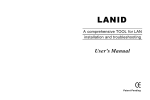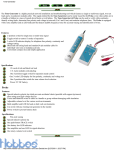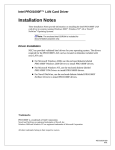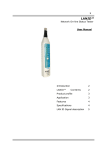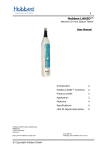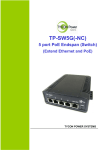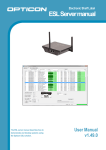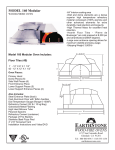Download LANIDgiga-giga LAN Device Status Identifier Model No.256655G
Transcript
LANIDgiga-giga LAN Device Status Identifier Model No.256655G Introductions The LANIDgiga is an advance edition of HOBBES LANID Pro with more capabilities. It is a high efficiency diagnostic tool for network installation and troubleshooting. With the LANIDgiga, network administrators can quickly confirm status of an active port. It will diagnose the problems during the LAN installation or maintenance on LAN devices or wall ports. The unit indicates whether the LAN equipment being tested supports the following topologies and capabilities: z z z z z z Auto negotiation 1000 BASE-T full duplex 100 BASE-Tx full duplex 100 BASE-Tx half duplex 10 BASE-T full duplex 10 BASE-T half duplex LANIDgiga also has an integrated PoE function to identify the existence of PoE and the type of PSE (power sourcing equipment) on the entire networks. What's more, the LANIDgiga is also equipped with a port-finder feature that helps to determine the workstation’s corresponding port: Just connect LANIDgiga to an unknown or unsure wall port and it will send a discontinuity 10/100/1000 auto-negotiation signal to communicate with Switch/Hub. LANIDgiga is a high efficiency diagnostic tool for all your networking and troubleshooting needs. Features z z z z z Check the existence of PoE Identifying the type of the PSE, whether the PoE voltage is detected on the pair 12-36 (EndSpan), or on the 45-78 (Midspan) Identifies the port speed up to Gigabit Two RJ45 plugs (one for testing Switch/Hub directly, the other for testing NIC) Port-finder function Instructions for Operation LANID Function: Step 1: Place the power switch to LANID position to turn power “on”. Step 2 : Push the LANIDgiga marked “HUB” into a HUB port, wall plate or patch panel that you will to test, or plug the provided patch cable into the “NIC” port on the right side of the LANID. Step 3: Push the “Test” button and read the results. The LANIDgiga will detects the status of the port and display the capabilities of the device connected as well as the link status. When a link is up, the “Link” LED will light up. The LAN device’s capability will be indicates by the LEDs (results will be displayed on the corresponding LED’s). AUTO,1000F, TX, 100F, 100H, 10F, 10H. If the PoE power existed in the pair 12-36, or 45-78, the corresponding LED will light up. Auto Link Auto Link ● ● ● ● 1000F TX 1000F TX ○ ○ ● ● 100F 100H 100F 100H ● ● ● ● 10F 10H ● ● 12-36 45-78 ○ POE ● 10F 10H ● ● 12-36 45-78 ○ POE POWER POWER ● ● Figure 1 ○ Figure2 Figure signal Description: Figure 1 Figure 1 shows the device is connected to HUB/NIC by auto-negotiation function and this HUB/NIC has 100/100 BASE TX half/full duplex ability. In addition, it also detected a POE power supplied on PIN 45-78 of RJ 45. Figure 2 Figure 2 shows the tested port has the capability for Gigabit (1000 Base-Tx full duplex) Fast Ethernet (100 Base-Tx full/half duplex) and standard Ethernet (10 Base-T full/half duplex) links with auto-negotiation support and there is no PoE voltage detected. Step 4 : After 15 seconds, all LEDs will shut “off” (except the POWER LED). Step 5 : Repeat step 3 and step 4 if you want to re-check or check other devices. Port finder Function: Step 1 : Place the switch to port-finder position. Step 2 : Connect the Hub/Switch by Jack or Socket, the LANIDGiga will send an auto-negotiation signals that can be trace back to a Hub/Switch (The corresponding LED indicator on the Hub/ Switch panel will blink).



